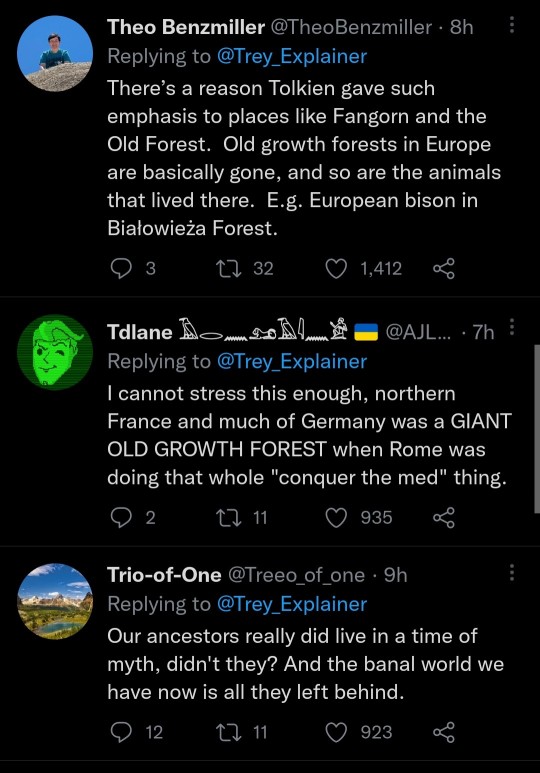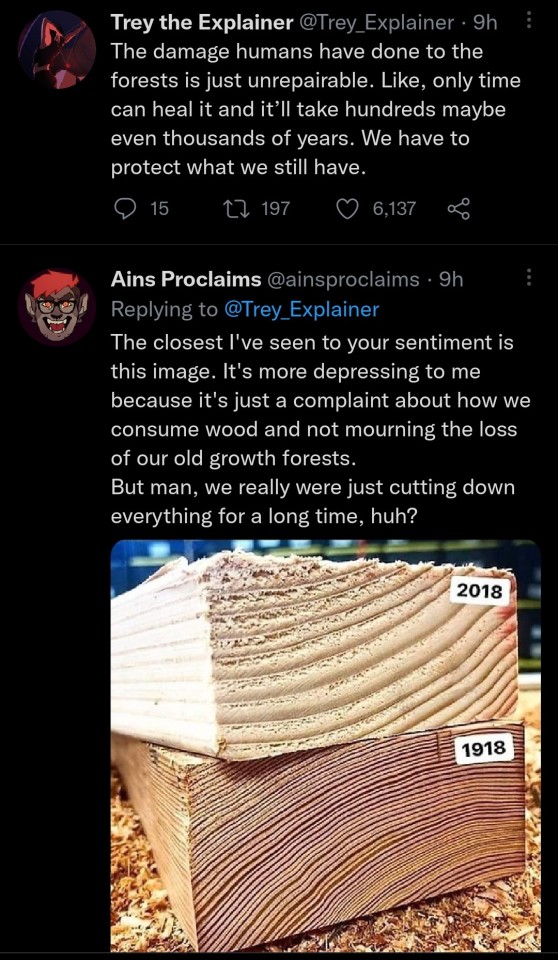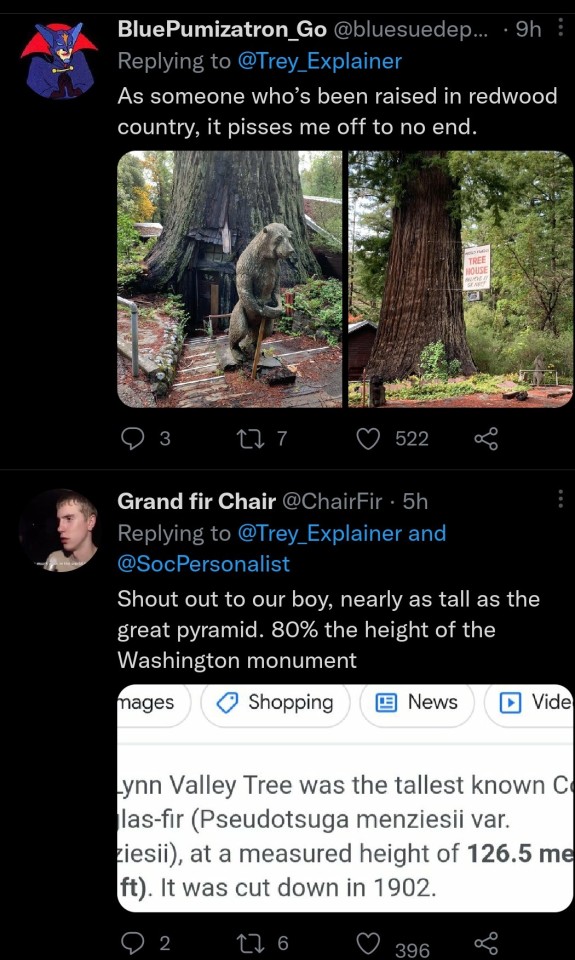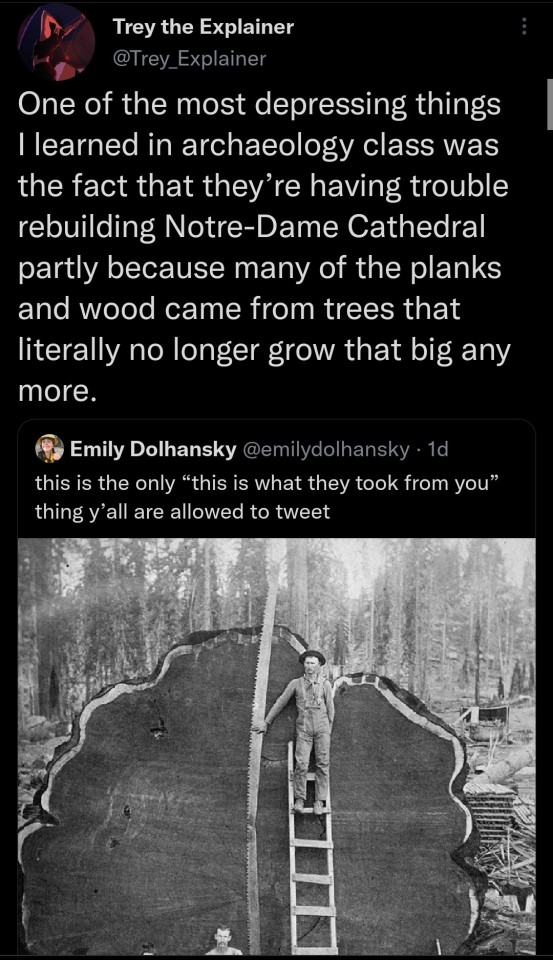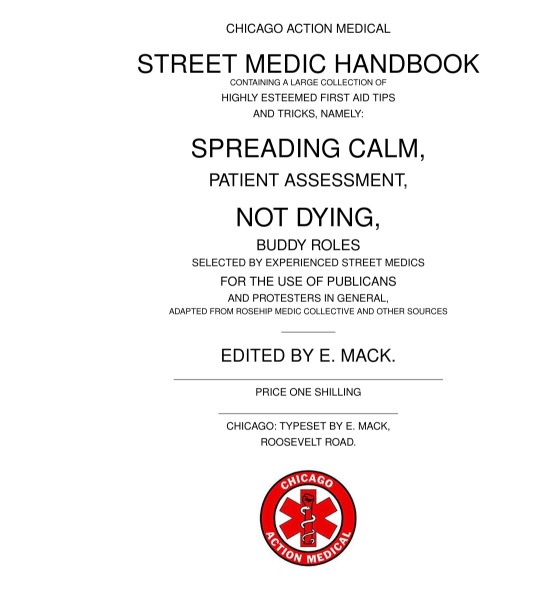Not really sure what I'm doing with this blog. I'm having fun though! I do not have a lot of energy; it might take me a while to respond.
Don't wanna be here? Send us removal request.
Text
Such a clever way of reusing generally discarded material! Defs taking notes here 😻
It's happening

22.02.2025
Upcycled seed trays and first sowing of the season...
🫑💜 bell pepper (cardinal)
🫑❤️ bell pepper (popti)
🌶💛 chilli (hot lemon)
🌶❤️ chilli (sizzler)
110 notes
·
View notes
Text
The closest experience I've ever had to discovering "the vitamin" was buying a 100% wool outfit and wearing it in the winter.
Not only was I not freezing anymore, I was not sweating and overheating either. The horrible sensory nightmare of winter clothes disappeared.
In particular, I bought a pair of wool pants. They were a thrifted pair of fancy dress pants like you would wear at an important office job, and they were easily the most comfortable pair of winter-appropriate pants i'd ever worn. I wore them Every Single Day.
From that point on I realized a lot of my clothes were making me feel bad, and the common thread was polyester. Especially polyester blends.
It's a trap because the polyester clothes are the ones that always feel sooooo silky soft when they are in the store, whereas cotton, linen and wool can feel comparatively rough and scratchy. But when actually wearing them for hours throughout the day, it's the natural fibers that feel more comfortable.
Maybe the secret to sensory comfort is not about the presence of softness, but the absence of overloading sensations. Or maybe the sensory stress and agony is not triggered by texture of the fabric, but by how it breathes and regulates temperature.
Then there's the problem of clothing life span: polyester blends, no matter how soft they seem at first, become rough and scratchy and covered in hard, itchy pills after wearing them 10 or 20 times, whether or not they have been tumble-dried or even washed at all. (I tested it!) Linen and cotton become softer and more comfy the more you wear them, polyester but ESPECIALLY polyester blends become a constant stressor. Polyester blend t-shirts I used to love for their softness now feel bristly and irritating.
So now I'm trying to change my wardrobe to as many natural fibers as possible, and the more natural fiber clothes i have the more I realize that the plastic fibers stress me out. It's so easy to overheat or freeze in them and they're always degrading and becoming less comfortable and it sucks.
26K notes
·
View notes
Text

Nothing against prev (I follow them and love their posts), but I keep seeing people using disabled people used as an argument towards cars, while, first of all, when a city is properly organised they do not need them and some have even asked to stop being used as a gotcha to promote car use, and secondly, there are so many better options. Cars need not be, nor should they be, the default to think of when thinking about (disabled) mobility.
I have decided to become a walkablity extremist.
Cars should not be allowed in towns and cities at all. The only places where they should be at all present is in rural areas where any other means of transportation should be impossible.
High speed rail networks should allow for a trip from Mexico city to Montreal in under 24 hours.
All public transportation should be 100% free.
Lawns should not exist.
It doesn't make sense for single family homes to be built in most American cities.
Architecture must be beautiful again.
Every commercial street should have at least one bench.
Public restrooms must be free, common and accessible.
The pigeons are not enemies. The pigeons are freinds.
#for example my father took a course in urban planning to keep up to date for his job#and there they said that while a lot of car dependent losers#who are too lazy to even walk twenty meters to their cans#(because the neighbourhood in question had a parking lot outside of it so that the area itself wasn't fuglied up with the disgusting things)#used disabled people as an argument to get their way#while when asked the disabled people in question did not mind#and while yes#cars can be useful#private cars are as dumb as private jets#only more normalised#there are plenty of mobility aids that make life liveable (not just surviveable) for people with mobility issues#they can still be motorised obviously#and still waste less material fuel and space than those metal garbage cans#while still providing enough space to bring stuff such as a bag or groceries or what have you#and for a lot of them it would even be an improvement#again i love and appreciate prevs blog#i just really really loathe cars and we should be honest about the damage they do#without inflating the possible benefits#bc yes they do have some benefits#but private cars do so so so much more harm#i might get myself yound up enough to make a post about that soon#with sources ofc
2K notes
·
View notes
Text
I have decided to become a walkablity extremist.
Cars should not be allowed in towns and cities at all. The only places where they should be at all present is in rural areas where any other means of transportation should be impossible.
High speed rail networks should allow for a trip from Mexico city to Montreal in under 24 hours.
All public transportation should be 100% free.
Lawns should not exist.
It doesn't make sense for single family homes to be built in most American cities.
Architecture must be beautiful again.
Every commercial street should have at least one bench.
Public restrooms must be free, common and accessible.
The pigeons are not enemies. The pigeons are freinds.
2K notes
·
View notes
Text
"What even IS Solarpunk?"
It's a social, artistic and environmental movement that aims toward a sustainable future via environmental activism and cultural education. (hence the "solar") Against climate doomerism, capitalism, and profit over anything else. Very DIY, counterculture, anarchism (hence the "punk")
So like: creating micro-self sufficient strategies that are accessible to everyone can apply to everyday life, helping pollinators, picking up trash, learning and teaching how to repair stuff, A LOTTTTT of upcycling, advocating for environmental causes, educating masses via literature and art and events and whatnot
(that's like, the "brochure" explanation. Then there's also the more chaotic and less legal actions like clandestine seed bombing, local creatures feeding, company boycotting in any fun way you can think of and moss grafitti)
How to stay active year-round?
Winter
- Host art workshops/soirées (nature themed, to make ornaments and stuff that can be sold in exhibitions, or just for fun and to raise awareness)
- Inside greenhouse prepping
- Teas and tincture making to give as gifts
- Donating clothes and shoes
- Looking into all the activist activities for the upcoming year, note important dates, be aware of demonstrations, colloques, expos, etc
Spring
- Early spring: throwing green grenades/ seed bombs
- Managing small outside cultures and inside greenhouse cultures: herbs, fruity , seasonals, etc
- Flower picking (to dry or whatever)
- garbage picking strolls
Summer
- Fruit drying/curing (to make ornaments, compostable water plates and infusions, etc)
- Herbs drying
- Making water drinking stations for local animals (out of hollow fruits) in dry areas
- Materials gathering (hay, seeds, dry branches, etc)
Fall
- Early fall: moss grafitti
- Knitting scarves to donate or sell for environmental organizations support
- Ornament making (to gift or sell in winter time)
- Art soirées (ornaments making, collages, "watchbooks")
- Garbage picking strolls
- Materials gathering (leaves, pinecones, sticks, etc)
- Feed local creatures and make safe spaces for them during winter
Year-round activities:
- Crafting, learning and educating: zines, tutorials, posters, books, etc
- Building stuff out of recycled materials
- Volunteering and donating to verified organizations
82 notes
·
View notes
Text
Low space & low budget weaving
Want to weave but don't have space for a loom? Have a few sticks and yarns but no DIY skills? Come, be tempted anyway. Weaving is a whole family of crafts, some of which don't require a loom at all.
Small-ish looms like box looms (as basic as yarn wrapped around a cardboard grocery tray), inkle looms, and rigid heddle looms exist, but I'm assuming every possible space for a box in your life is already filled. In this post we're going even smaller and cheaper. As far as possible, everything either is flat enough to stow behind/under furniture or rolls up safely into a bundle of just sticks and yarn.
Many of these crafts have some crossover - the same setup can be used for multiple styles of weaving. Most of them can be improvised at home depending on what you have on hand, or if you need to buy something there is not a huge gulf between homemade vs professional equipment. Alas I am not skilled in any of these and my descriptions will not be wholly accurate; corrections and additions welcome! If you need help, I'd only be able to tell you to seek out books and tutorials yourself, ask other weavers, and just try stuff out.
All photos included with permission. My thanks to the people allowing me to use their projects! I saw so many gorgeous and skillful projects when assembling this and I wish I could have included them all.
Fingerweaving
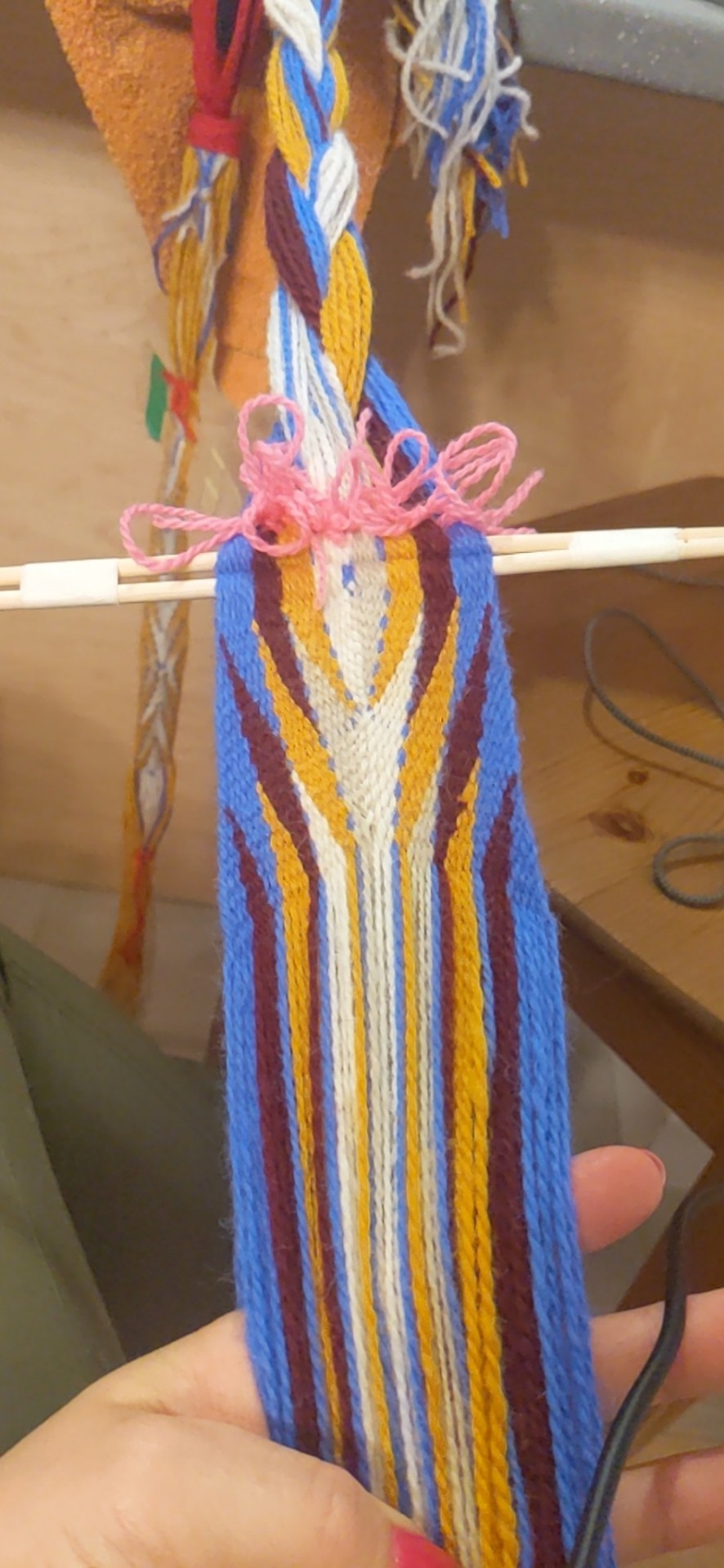

Projects by @kitteniestkitten (here) and @wefty-weaver (here)
Culture - I am aware of this as a Native American technique, I don't know its history with any more specific tribe.
Fabric - "Warp faced" cloth of any width, insofar as warp and weft have meaning for this craft as the weaving is on a diagonal. Often used for sashes or blankets.
Method - There is no loom! A couple sticks hold the yarns to begin with, but then it is all freehand. Starting at one corner, you use your fingers to weave a strand through the other strands, and... that's it. Very simple beginnings work up to very complex patterns that no loom is capable of. The whole project can be rolled up when not active.
Backstrap loom

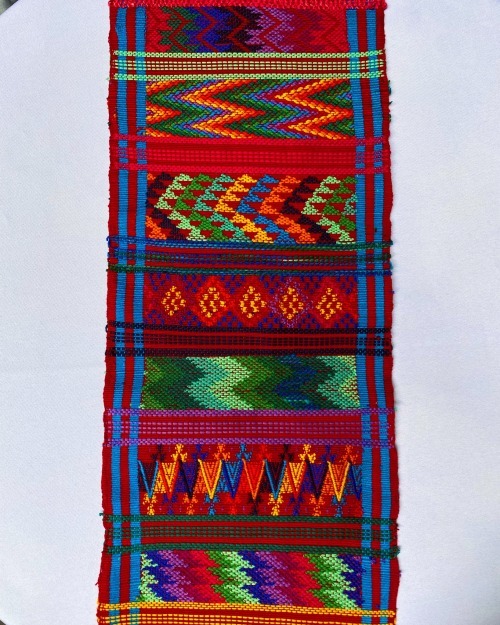
Projects by @calendae-creations (here) and @weavingforlooms (here)
Culture - I am most aware of this from the Andes but I think it is much more widespread than that.
Fabric - Warp faced or balanced fabric of any width up to your own reach, suitable for blankets and clothes and many other things.
Method - You are the loom! Several horizontal rods hold and manipulate the warp threads but your body provides the tension, with the other end hooked to some furniture or around your own feet. When not in use, you can roll up all the equipment into a small bundle of yarn and rods. You can also use a backstrap loom setup for other methods like tablet weaving.
Warp weighted loom

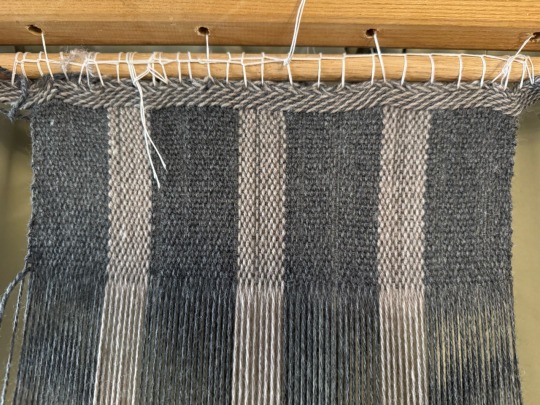
Projects by @shadowcreepling (here) and @doctormead (here)
Culture - used by ancient Greeks among many many others.
Fabric - any kind of fabric at any size. Shadowcreepling is using a warp weighted loom for a tablet-woven band, Doctormead is probably using heddle rods to make a wider piece of cloth.
Method - the warp threads are held by a bar at the top and tensioned with weights on one end that hang down towards the floor, then the weft is woven into them with any method such as tablets, heddle rods, or by hand (if you have a lot of patience) and beaten into firm fabric at the top or bottom of the loom. Warp weighted looms can be very big, but they are simple and can also be very small and taken apart when not actively weaving.
Tablet weaving / card weaving


Projects by @damage-ko (here) and @foxease (here, hardware from CellesKit on Etsy)
Culture - found as far apart as textiles (geographically and temporally) from Byzantine Egypt and the Vikings
Fabric - a warp faced fabric with patterns made by twining warp threads around each other, usually used for strong narrow bands like collars, belts, and shoelaces.
Method - the cards hold open the shed so you can pass the weft through, then rotate the cards to advance the pattern. Many people make their own with cardboard or playing cards, or you can buy some. The rest of the weaving setup can be improvised with a backstrap (or just a shower curtain hook clipped to your trousers), a cardboard box loom, or warp weights.
Rigid heddle band weaving


Projects by @pisaracraft (here) and @crookedtines (here)
Culture - small rigid heddles like the first project have been found in Roman archaeological sites across Europe. The larger rigid heddle in the second project is being used for "baltic pickup" style designs on the band.
Fabric - can be warp faced or a balanced weave, size limited by the size of your heddle.
Method - you provide tension with any setup you please such as an inkle loom, backstrap, or warp weights. The heddle creates sheds so that you can pass weft yarn through the warp easily. Infinitely many "pick-up patterns" let you weave patterns and even words into the cloth.
Pin loom / potholder loom
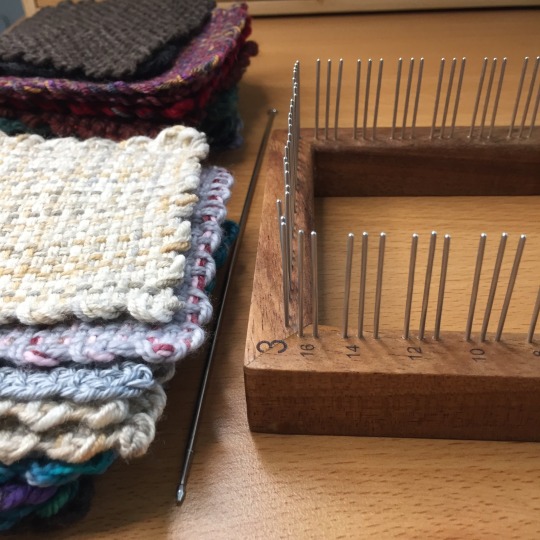

Projects by @pardalote (here) and @weavingmyheartout (here)
Fabric - a small square (or rectangle or triangle) of balanced weaving, which can be used alone or patched together into larger fabrics. Pin looms are finer and suitable for many knitting/crochet yarns, potholer looms are chunkier and designed for big elastics, but the method is similar.
Method - wind yarn lengthways around one set of pins and then pull yarn widthways through these strands with a hook. Or, work at 45 degrees in continuous strand weaving! Lots of room to experiment with colour and texture. You can improvise a pin loom by cutting notches in a square of sturdy cardboard.
Needle weaving / stick weaving / peg loom
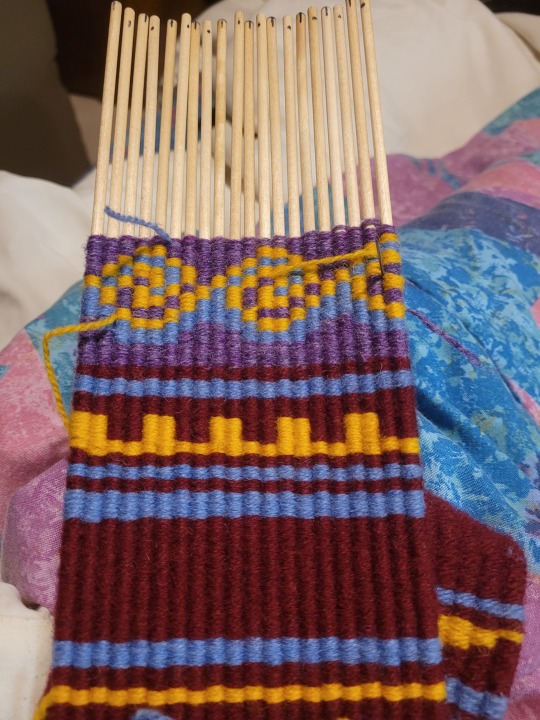

Projects by @thaylepo (here) and @pastelispunx (here)
Fabric - weft-faced fabric and rugs of any size.
Method - thread long thin warp threads through the pegs, then wind a thick weft (eg heavier yarn, sheep fleece, or long scraps of fabric) around the pegs. Push the weft down along the pegs as they fill up, so that it slides off onto the warp. The pegs can be secured in a base to make a peg loom for large projects, or just handled freely. I believe these evolved as separate crafts and the nuances are different, but the overall method is similar.
Frame loom / tapestry loom


Projects by @squeakygeeky (here) and @battlestar-gasmacktica (here)
Fabric - weft-faced or balanced fabric ideal for wall hangings and upholstery, size limited to the frame being used.
Method - (usually) thinner warp threads are wound round a frame, such as heavy cardboard with notches cut in the end, a picture frame, or a small and flat purpose-made loom. Thicker weft threads are woven in by hand using needles or just small lengths of yarn. Some people make lifelike images, others make more ordinary fabrics or geometric patterns.
Bobbin lace
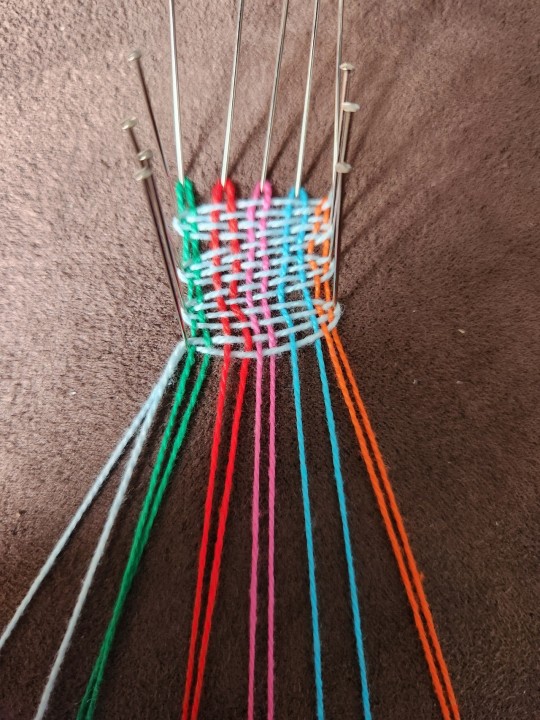
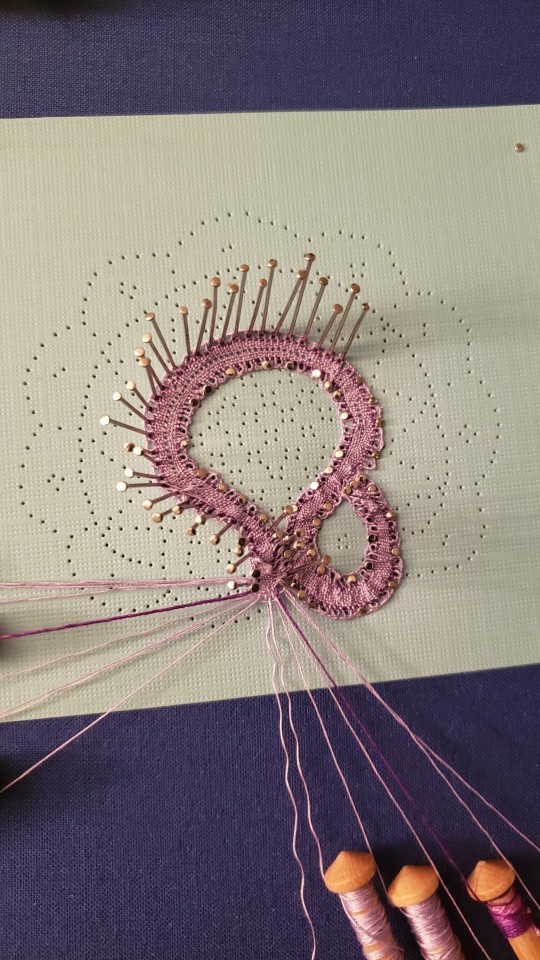
Projects by @crochetpiece (here) and @noxx-notions (here)
Culture - began in renaissance Italy and spread throughout Europe, often as a cottage industry.
Fabric - balanced fabric usually made of very thin threads in freeform shapes. It's not usually considered "weaving" but the basic cloth stitch is definitely a woven fabric!
Method - each thread is wound onto a bobbin (e.g. a clothespeg) and then bobbins are crossed over each other to weave threads together. The lace is pinned to a cushion to hold everything in place while the design grows.
4K notes
·
View notes
Text
a whole bunch of gazan mutual aid projects and nonprofits. if the decision of which individual fundraiser to give to feels too daunting, or if you just want to help as many people as possible in one go, these are great initiatives to support.
care for gaza - focuses on providing food and essential supplies. donate here or here.
connecting humanity - securing internet access via donations of virtual sim cards (esims). if you can't afford a whole plan yourself, crips for esims is a communal pool that will use your donation to purchase and maintain esims
gaza soup kitchen - provides food, medical care, and classes for children. also has a gofundme
glia gaza medical support initiative - provides medical care through field clinics and tents at hospitals. donations can also be sent through their website.
ele elna elak - provides clean water, food, clothing, and shelter. they also have a gofundme
life for gaza - raising money for the gaza municipality to repair water and waste management infrastructure
taawon - partners with local civil organizations to provide food, water, medical care, shelter, and basic supplies
the sameer project - running various initiatives providing tents, medical care, and necessities. they have their own encampment project focused on sheltering families with children, sick and disabled members, or members in need of perinatal care
islamic relief worldwide's gaza emergency appeal - provides food, water, hygiene kits, medical supplies, and psychological support
baitulmaal - provides a variety of necessities, including food, water, shelter, and medical supplies
gaza mutual aid fund - distributes food, hygiene products, water, and other essential supplies, including financial support. run by @/el-shab-hussein's amazing friend Mona. updates can be found on her instagram.
hygiene kits for gaza - provides hygiene supplies including menstrual products, wipes, and toothbrushes/toothpaste
anera - provides a variety of necessities, including food, water, hygiene supplies, medicine, blankets and mattresses, and psychological care
palestine children's relief fund - provides supplies and support with a focus on children. also has an initiative for lebanon
dahnoun mutual aid - provides water, food, tents, baby supplies, financial support, and other necessities. updates can be found through their instagram
certainly this is not an exhaustive list, so please feel free to add on other projects or organizations that i didn't include. and as always, please take the time to donate if you can and share. it truly makes all the difference.
136K notes
·
View notes
Text



Can you reblog with photos of your cats please?
24 notes
·
View notes
Text
The whole debate is exhausting. There is literally no upside to GenAI. Why do people still need to be asked this.

2K notes
·
View notes
Text
So, like, universal basic income.
One of the things I’ve heard people say is how, you know, you need income as a motivation to make people work. And I’ve heard some great arguments against that.
But also.
There are a lot of low-paid jobs that actually make the world a crappier place. Like, if we could just pay everyone in the fast fashion industry to stay home and not go to work, the world would be a much better place. If we paid people enough that they didn’t need to work in factories, then large-scale manufacture of crappy stuff wouldn’t be feasible anymore.
Like, we’re basically in a post-scarcity society. We have more than enough food and clothing for everyone. This manic capitalist mindset where we force people to go to jobs they hate to remove value from the world is insane, right?
And maybe if we instituted this we’d lose fast food corporations and stuff. But I bet they’d be replaced by small restaurants run by people who are passionate about what they do.
3K notes
·
View notes
Text
In case anyone is having a bad night
(The best of this post and its reblogs, but with links that work)
Here is a website where you can scroll down to all the different levels of the ocean
Here is a website where you can see the future of the universe
Here is a website where you can press a ‘make everything okay’ button, over and over, until things really are okay
Here is a website that you can read if you feel like a burden
Here is a website where you can look at strobe illusions (TW strobe/flashing)
Here is a website where you can cut stuff up (TW blood/sh)
Here and here are websites where you can play with sand
Here is a website where you can draw with macaroni and other fun foods
Here is a website where you can paint someone’s nails
Here is a website where you can grow a garden with emojis
Here is a website with hundreds of videos of people hugging you (rightfully dubbed ‘the nicest place on the internet’ because it really is, y’all, it made me cry)
Here is a website that will take you to other useless websites
Here is a website where you can make a tiny cat play bongo drums (and other instruments!)
Here is a website to help give you gentle reminders <3
Here is a website where you can grow a tiny farm
Here is a website where you can take a bunch of scientific personality tests
Here is a website of calm rain noise
Take a breath. It’s going to be okay, I promise.
25K notes
·
View notes
Text
a really great organization that i don't see any posts about here is HEAL palestine. it was founded by steve sosebee, who was a founding president of the PCRF before leaving in late 2023 to refocus his efforts on heal palestine to better meet the needs of palestinians impacted by the genocide. the organization provides palestinians in gaza with food, clean water, shelters, "makeshift classrooms," and even medical evacuation for some children when it's possible--their services are pretty wide.
you can donate here if you would like to send a tax-deductible donation to an organization. also, i don't think any evacuations are possible right now, but if you're in the united states and you'd like to welcome medically evacuated children in the future, i highly recommend signing up for their newsletter or following them on social media so you can stay updated in case any children evacuated by HEAL come to your area for treatment. welcoming these kids at the airport is a really moving way to provide them with moral support, entirely for free.
31K notes
·
View notes
Text
Literally sensing that no one gives a fuck anymore so friendly reminder to keep boycotting all BDS products as well as any brands linked to Israel in any way
This is a lifestyle change rather than something you temporarily commit to and then drop for mediocre watered down coffee
12K notes
·
View notes
